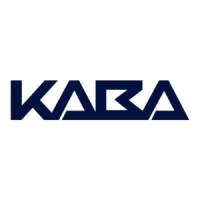14 k1evo706en-2011-07 Kaba Terminal 9420 MID
Product description User manual
3.9 Installation preparations
3.9.1 IT infrastructure
How the terminal is installed and configured depends on the existing IT
infrastructure, which can vary from company to company, particularly with regard
to network security guidelines.
Prior to installation, any IT-relevant queries must be clarified with the customer's IT
department. The following checklists are intended to assist when clarifying queries:
Check Measures
1) Is the terminal being used in a DNS
Server environment or only with
DHCP?
Refer to settings when configuring B-
COMM Java (Ch. 5.4.2)
2) Are there any naming conventions
for the connection of network
devices to the corporate network?
If there are, the Kaba standard name
must be adjusted manually in the
terminal before starting the
installation and configuration process
(Ch. 6.4.4)
3) Is the terminal operated with a
static IP address?
If operation is with a static IP address,
this must be set manually in the
terminal before starting the
installation and configuration process
(Ch. 6.4.5)
4) The following ports are used for
network communication:
- TCP 20, TCP 21 (note the FTP for
parameters)
- TCP 80 for normal communication
- UDP 1900 SSDP protocol
Ports must be enabled by IT.
5) The following ports are used for
local (client) communication:
- TCP 1433 SQL communication
- TCP 1099 JAVA
- TCP 3001 and TCP 3005 BCOMM
JAVA
Ports must be enabled in the Windows
firewall.
6) Can Java be installed on a local
computer?

